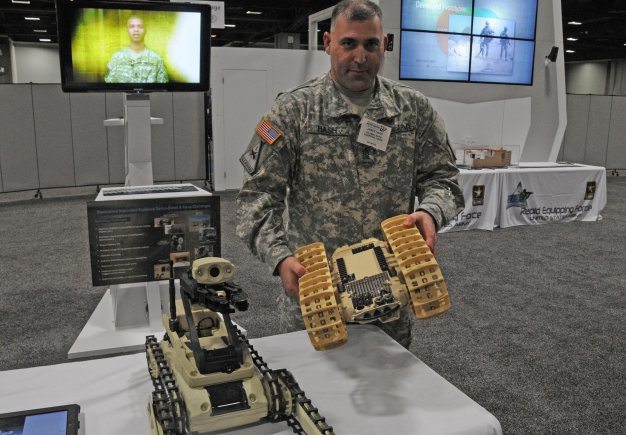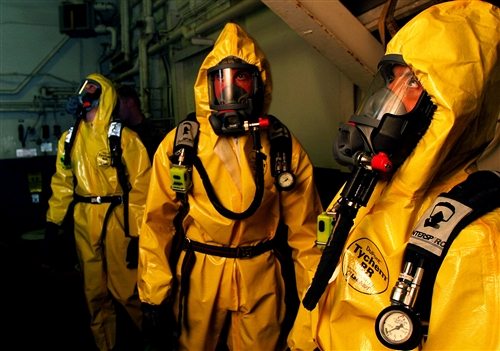The Army’s Rapid Equipping Force launched a website two weeks ago to solicit ideas and input from Soldiers, industry and tinkerers.
These ideas are helping bring “modern technologies and solutions to the battlefield,” said Col. Timothy Hill, director of the Operational Energy/Contingency Basing Task Force, which works closely with the Rapid Equipping Force, or REF.
Hill spoke while visiting the REF’s modern weapons and equipment display at the 2013 Washington Auto Show, last week in the nation’s capital.
An example of what the REF delivered to Soldiers in Afghanistan and elsewhere is a solar technology system, solar panels used to replace petroleum-based generators, tested during Network Integration Evaluation 13.1 in November at the White Sands Missile Range, New Mexico and on display at the Washington Auto Show.
During NIE 13.1, Hill spoke to an armored brigade commander who was using the solar panels.
“He said it saved a lot of fuel and built flexibility into the force,” Hill said, explaining that logistics deliveries were reduced and the tanks and other equipment could realize added “efficiencies and effectiveness.”
He said similar logistics advantages were seen with new water-purification systems that had been fielded through the REF.
Soldiers who have served multiple tours in Iraq and Afghanistan have also come to appreciate the work that REF has done.
When Sgt. 1st Class Mario Whitaker first deployed to Iraq in 2004, a lot of the latest technology fielded by the REF was not yet on the ground, as the REF had only been stood up less than two years earlier and new gear was still in the pipeline.
“We had none of this,” Whitaker said, pointing around at the REF equipment on display at the auto show. “We got around in soft-shell Humvees,” he added.
Two years later, Whitaker was back in Iraq.
“This time, we were rolling around in Up-Armored Humvees and we had stuff like the Minotaur and the Mine Hound,” he said, pointing to some of the equipment used for mine and improvised explosive device, or IED, detection and destruction.
“I didn’t know about REF when I was in Iraq and saw these new technologies coming in,” he said, “but now I have a greater appreciation for what the organization does.”
Whitaker is currently an operations noncommissioned officer at REF headquarters at Fort Belvoir, Va. He said REF-funded technologies are now saving the lives of Soldiers in Afghanistan, a place he visited recently.
Sgt. Maj. James Hash, one of the senior enlisted Soldiers at REF, is another believer in what his organization does. He observed first-hand the REF-funded, life-saving technologies, particularly in ground robotics systems, unmanned aerial vehicles and IED-detection equipment, during a recent tour in Afghanistan. He saw technologies Soldiers didn’t have during his 2003 deployment to Iraq.
As the war in Afghanistan draws down, Hash said, REF-funded technologies will become even more critical because Soldiers will be spread thin in distant combat outposts, and other Soldiers, particularly those in Special Operations in Africa and South America, have a need for cutting-edge technologies.
The REF doesn’t operate in a vacuum, he pointed out. It partners with PEO Soldier, the Asymmetric Warfare Group, Training & Doctrine Command, Army Medicine, the other services and outside organizations, collaborating and avoiding redundancy of efforts.
However, a lot of ideas come from the Soldiers themselves, he said, citing Minotaur.
As he spoke, Katherine Hammack, assistant secretary of the Army for Installations, Energy and Environment, stopped by to chat with the REF Soldiers. She particularly liked the Minotaur, which is a redesigned Bobcat used for IED detection and destruction.
Minotaur is slim and small and can go down mountain paths in Afghanistan where other vehicles can’t, she said. Also, it is remote-controlled so a squad can follow from behind it at a safe distance.
Hash agreed, adding that when one of them hit an IED, it bent some of the plow-like devices in the front, which were readily repaired with Minotaur returning quickly to patrols.
Hammack said REF looks for new technologies, like from the big companies at the auto show, but works just as diligently with small entrepreneurs which have unique capabilities that Soldiers can use. One technology being explored from a small business, she said, is a wireless charging system that would enable a Soldier to recharge the battery that operates his gear remotely, within about 10 feet of a vehicle. Thus, the Soldier could be powered up without unplugging his battery, saving time, she said.
Batteries are used for a lot of devices the Soldier carries, including night vision goggles and smartphones with apps that were fielded by the REF.
Hash said the key to “Rapid” in its title is that the organization “is not bound by the traditional military acquisition process. We can field stuff as quickly as 90 days, but more complicated things like Minotaur took about seven months.” Still, that is fast, he said, because new gear typically takes years to field.
Soldiers who work at REF also routinely go to the field to get feedback from the users of the new systems, and if the systems need tweaking, they are tweaked and if they are good to go, they can go through the traditional acquisition process for distribution throughout the Army, Hash added.











